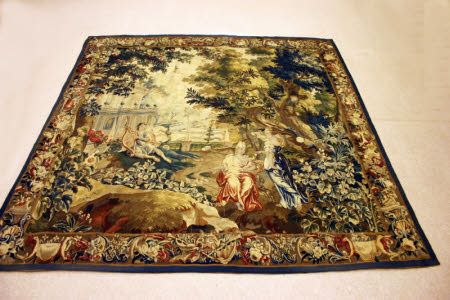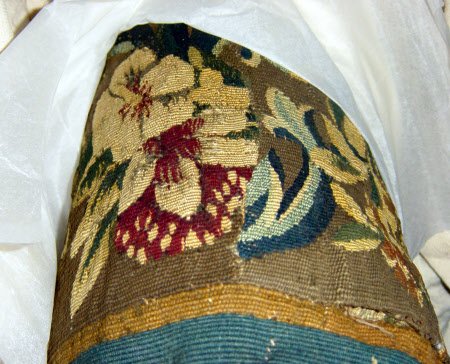Apollo
Flemish
Category
Tapestries
Date
circa 1690 - circa 1710
Materials
Tapestry, wool and silk, 6½ warps per cm
Measurements
2.62 x 2.63 metres
Place of origin
Belgium
Order this imageCollection
Blickling Hall, Norfolk
NT 355773
Summary
Tapestry, wool and silk, 6½ warps per cm, Apollo from a set of three Mythological Scenes, Flemish, c. 1690-1710. In the right foreground a woman in a red dress sits on chair with golden lions' feet, a small dog in her lap. A standing woman in a blue dress offers a titbit to the dog, and another dog jumps up. Further back to the left a young man with golden hair and a laurel wreath on his head sits on a grassy bank playing the harp. Behind him is a parterre and a classical building with golden statues in niches, and to the right behind the women there is a dense forest. The borders, which have been attached from an unrelated tapestry, are composed of flowers, leaves and scrolls on a light brown ground with helmets and crossed bugles at the top and bottom, and in two military saddles at each side of the lower border. (Helen Wyld, 2011)
Full description
The subject of the three tapestries at Blickling is unclear. In one of the scenes a young man wearing a laurel wreath, possibly the god Apollo, sits on a grassy bank playing a harp while two young women play with dogs nearby. In the second tapestry a woman steals jewels from a sleeping companion who has a bow and a quiver of arrows, and may be Diana, Apollo's sister. In the third scene two young women with no obvious attributes recline in a formal garden. The elongated figures in stiff, slightly theatrical poses with lively drapery, and the ambiguous sense of narrative action, are reminiscent of the style popularised by the tapestry designer Lodewijk van Schoor (d. 1702) in the 1680s. Van Schoor provided figures for a number of tapestry series produced in Brussels, Antwerp and elsewhere, with allegorical or mythological subjects such as 'Apollo, Minerva and the Muses', 'The Twelve Months', 'Ovid's Metamorphoses', and 'The Four Continents and Related Allegories' (see for example a tapestry of 'Africa' at Packwood House, no. 557900). Many of Van Schoor's designs rely on elegant and sumptuously clad allegorical female figures, but often lack a clear narrative (Brosens, 2004). The present tapestries, although probably not designed by van Schoor, seem to be inspired by his example. The borders, which include details of saddles, bugles and helmets, are of finer quality than the central scenes (7½ rather than 6½ warps per cm) and have obviously been applied from a different tapestry set. The tapestries, formerly a set of four, were hung in the Morning Room (today known as the Brown Drawing Room) by 1899. Four tapestries were recorded here in the 1930 inventory of the house, and by 1948 they had been moved to the Great Hall. One tapestry from the set was sold at some point prior to this. Two of those that remained were subsequently hung in their present location in Lothian Row. (Helen Wyld, 2011)
Provenance
Bequeathed with the hall and contents to the National Trust by Philip, 11th Marquess of Lothian (1882-1940)
Credit line
Blickling Hall, The Lothian Collection (The National Trust)
Makers and roles
Flemish, workshop possibly Oudenaarde, workshop
References
Brosens, 2004: Koenraad Brosens, A Contextual Study of Brussels Tapestry, 1670-1770. The Dye Works and Tapestry Workshop of Urbanus Leyniers (1674-1747), Brussels 2004


